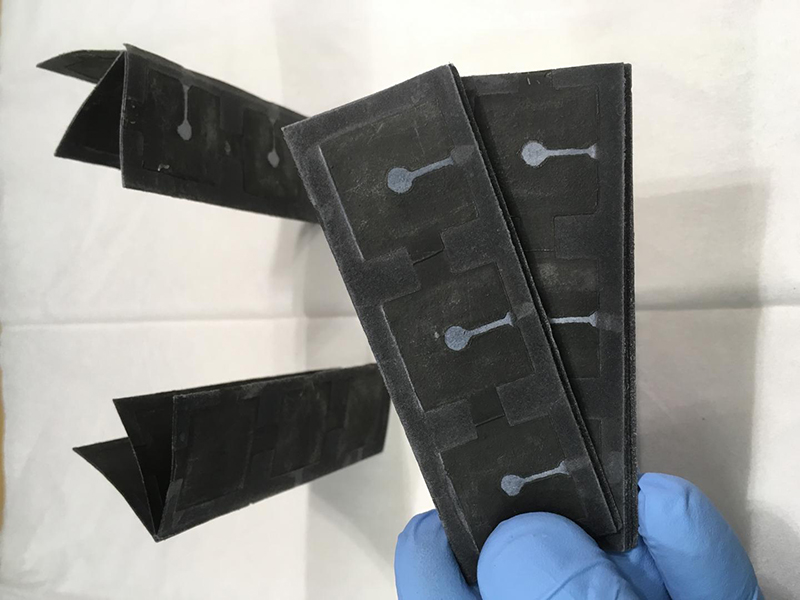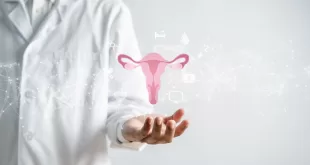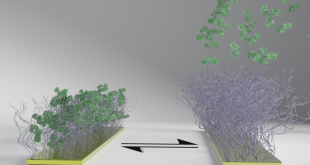Biobatteries & e-skins
Associate Professor Seokheun (Sean) Choi and his research team at Binghamton University, State University of New York, developed a bio-based paper battery that uses bacteria to produce power. On a piece of chromatography paper, a ribbon of silver nitrate is placed under a layer of wax to create a cathode, while conductive polymer is applied on a separate area to act as the anode – the piece is then folded together, and a few drops of bacteria-filled liquid are added. The elements interact to produce power generated by the microbes’ cellular respiration.
“Papertronics have recently emerged as a simple and low-cost way to power disposable point-of-care diagnostic sensors,” Choi explains. “We are excited about this because microorganisms can harvest electrical power from any type of biodegradable source, like wastewater, that is readily available. I believe this type of paper biobattery can be a future power source for papertronics.” The design could revolutionize the use of biobatteries as a power source in remote, dangerous and resource-limited areas.
Different folding and stacking methods can significantly improve power and current outputs. Although it would take millions of paper batteries to power a common 40-watt light bulb, they can produce enough power to run biosensors that monitor glucose levels in diabetes patients, detect pathogens in a body or perform other life-saving functions.
Another biobattery recently developed by Choi in collaboration with Professor Omowunmi Sadik, from the Binghamton University Chemistry Department, uses a hybrid of paper and engineered polymers that easily biodegrades in water. The polymer-paper structures are lightweight, low-cost and flexible.
This year, the National Science Foundation awarded a $452,000 grant to Choi and his associates at Binghamton University for research to generate power from human sweat, using the metabolisms of sweat-eating bacteria incorporated into a flexible, stretchable and self-healing electronics “skin,” or e-skin, which mimics the functionalities of human skin. “The proposed sweat-powered batteries will be based on microbial fuel cells (MFCs), which will exploit sweat-eating bacteria to transform the chemical energy of sweat into electrical power,” Choi explains. “Excitement is building for scavenging power from sweat, as it is the most suitable energy source for skin-contacting devices.”
E-skins have recently emerged as a novel platform for electronics, taking on more important roles in health diagnostics, therapeutics and monitoring. Stand-alone and self-sustained e-skins are essential to providing reliable, effective and sometimes life-saving functions. Choi believes these devices are the future of technology:
“With the development of stretchable, biocompatible and self-healing electronic materials, significant research efforts are dedicated to the seamless and intimate integration of electronics with human skin, which will produce breakthroughs in human-machine interfaces, health monitoring, transdermal drug delivery and soft robotics. As the emerging technologies of artificial intelligence and the Internet of Things are advancing at a rapid pace, e-skins will definitely be one of the ultimate forms of next-generation electronics.”
Electric vehicles
China: In 2018, with sales topping 1.1 million, this country purchased more than half of all EVs sold worldwide; China also makes more than half of the world’s EV batteries. There are already around 200 million electric bicycles, scooters and motorbikes in China.
France: By 2040, the country plans to ban sales of all gas- and diesel-powered cars.
Japan: Toyota Motor Corp. is investing $13.9 billion into its solid-state battery operations, with plans for half of its global sales to be EVs by 2025.
Norway: By 2025, only 100 per cent electric or hybrid cars can be sold.
Many other countries (including Canada) are developing similar targets.

Clean power
Australia: In late 2017, the world’s first solar-powered train started running in New South Wales, along a three-kilometre track that had been inoperable for more than a decade. The Byron Bay Railroad Company refurbished two vintage rail cars (dating to 1949 and 1962), adding roof-mounted solar panels that generate up to 6.5kW of power and replacing one of the diesel engines with a pair of electric traction motors, traction inverters and a lithium-ion battery bank; the other engine was replaced with a clean-burning diesel unit that acts as a backup power source in case of an electrical fault, and also provides weight and balance. All lighting was replaced with LEDs. A large array of solar panels on the train storage shed roof are capable of producing an additional 30kW. Over a 12-month period, the combined solar generation is enough to power the 100-passenger train daily, plus 17.5 three-person homes for a year; surplus energy is exported to the grid. The train is also equipped with a regenerative braking system that turns the traction motors into generators during braking to recharge the batteries. The lightweight aluminum rail cars can travel at speeds up to 115 km/h.
Costa Rica: 2018 was the fourth year in a row that the country generated more than 98 per cent of its electricity from renewable sources. Hydroelectric plants generated more than 70 per cent, followed by wind at more than 15 per cent and geothermal at more than 8 per cent; solar and biomass each generated less than 1 per cent.
Denmark: In 2017, the country set a world record by supplying 43 per cent of its electricity consumption by wind power.
Germany: In the first half of 2018, the country generated enough renewable energy to power every household for a year.
India: As part of the Indian government’s National Solar Mission, Indian Railways plans to commission 1,000 megawatts of solar power across its network by 2020, with another 200 MW from wind power plants. With more than 20 million passengers daily, the railway company consumes nearly two per cent of the nation’s power. The overall reduction in fossil fuel use and other energy-saving initiatives are expected to cut emissions by at least 457 million tonnes of CO2 over a 30-year period.
Nicaragua: The country plans to use at least 90 per cent renewable energy by 2020. The majority of its renewable power is now generated by wind, with recent estimates at 20 to 30 per cent of total electricity generation.
Scotland: In October 2018, the country generated 98 per cent of its electricity from wind power.
United States: In early 2019, Amazon.com announced three new renewable energy projects as part of its long-term goal to use 100 per cent renewable energy to power Amazon Web Services (AWS). In 2018, AWS was already using more than 50 per cent renewable energy, but the upcoming wind generator projects in Ireland, Sweden and California are expected to generate more than 670,000 megawatt hours of energy annually. In combination with AWS’s previous renewable energy sites, the company expects to generate the equivalent to powering more than 262,000 homes, or a city the size of Nashville, Tennessee. In total, Amazon has enabled 53 wind and solar projects worldwide; the company also recently announced its goal to make all shipments net zero carbon, with 50 per cent of all shipments net zero by 2030.
Also this year, Chicago became the largest U.S. city to commit to 100 per cent renewable energy before mid-century. The city passed a resolution to use 100 per cent renewable energy in buildings by 2035, and electrification of the region’s bus fleet by 2040. More than 100 other U.S. cities have adopted clean energy goals.
 BioLab Business Magazine Together, we reach farther into the Canadian Science community
BioLab Business Magazine Together, we reach farther into the Canadian Science community





